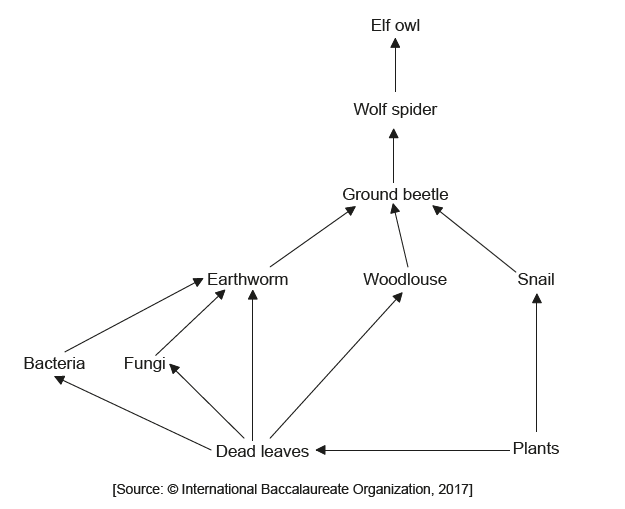Question
Explain the movement of energy and inorganic nutrients in an ecosystem [7]
▶️Answer/Explanation
Ans
a autotrophs/producers/plants obtain inorganic nutrients from the «abiotic» environment Award if only energy is mentioned.
b energy is provided «mainly» by sunlight c light energy is converted «to chemical energy» through photosynthesis
d photosynthesis/producers/autotrophs convert inorganic carbon/carbon dioxide and water into carbon/organic compounds
e carbon compounds/foods contain/are a source of «usable» energy «for life»
f carbon compounds/energy are transferred along food chains when eaten by consumers/heterotrophs
g respiration returns carbon «dioxide» to the environment
h respiration releases stored/chemical energy as heat/ATP
i energy/ATP is used to carry out life functions/synthesis/growth/movement
j energy is lost/is not recycled Both related by “or” required.
k nutrients are recycled / example of recycled nutrient e.g. carbon
l decomposers recycle minerals/inorganic nutrients
Question
The image shows a food web.

Using the food web, identify a detritivore.
Using the food web, identify a saprotroph.
State the name of the domain to which birds, such as the Elf owl, belong.
Outline the energy flow through this food web.
▶️Answer/Explanation
Markscheme
earthworm/woodlouse
bacteria/fungi
Do not accept protozoans or nematodes as they are consumers.
eukaryote/eukaryota/eukarya
a. light energy of Sun is converted by plant/autotroph to chemical energy «in carbon compounds through photosynthesis»
b. detritivores/saprotrophs decay plant material «that accumulates in the soil» to obtain energy OWTTE
c. consumers release energy from the carbon compounds by cell respiration energy lost as heat
d. energy is used by organisms for metabolism
e. energy is transferred between organisms/trophic levels through the food chains/web
For mp e, accept specific example such as energy is transferred from primary to secondary consumer etc.
f. energy is lost at each trophic level «so lengths of food chains/web are restricted»
OR
approximately 80/90 % of energy is lost «between trophic levels»
Vice versa
Award mark points that refer to the specific organisms from this food web.
Question
Draw a labelled diagram of a eukaryotic plant cell as seen in an electron micrograph.
Outline how the energy flow through food chains limits their length.
In hot, dry conditions plants lose water rapidly due to transpiration. Explain how the structures and processes of the plant allow this water to be replaced.
▶️Answer/Explanation
Markscheme
Cell wall shown with two continuous lines to indicate the thickness
Plasma membrane/cell membrane shown as a single continuous line
Accept inner line of wall as membrane if clearly labelled.
Nuclear membrane/nucleus shown with double membrane and nuclear pores
Vacuole «membrane»/tonoplast shown as a single continuous line
Chloroplast/plastid shown with a double line to indicate the envelope and thylakoids/grana
Mitochondrion shown with double membrane/cristae
Only a small proportion/20 %/10 % «of energy» can pass from one trophic level to the next Accept named trophic levels or named stages in a food chain in place of “trophic levels”.
OR
large proportion/80 %/90 % lost between one trophic level and the next Accept if clearly shown in a diagram such as a pyramid of energy.
Energy released by respiration AND lost as heat Not just respiration or heat.
Energy losses due to uneaten parts/undigested parts/feces/egestion
Not enough energy for 4th/5th/later stages of a food chain
OR
more energy available if feeding at an earlier stage in a food chain
Evaporation of water «in leaf/mesophyll» creates tension/low pressure/negative pressure «potential»/pulling force/transpiration pull
Water drawn through cell walls/out of xylem «in leaf» by capillary action/adhesion «to cellulose»
Low pressure/tension/suction/pulling force in xylem
Hydrogen bonds make water cohesive/allow water to be pulled up under tension/allow the transpiration pull «to move water»
Xylem resists tension/low pressure/collapse with thickened/lignified walls
Water travels from the roots to the leaves in xylem
Water absorbed in roots by osmosis
Active transport of ions/solutes into roots «enabling osmosis»
Deep/wide ranging/extensive root systems/taproots/many root hairs
Thick/waxy cuticle reduces transpiration/water loss/evaporation
Small/no leaves/reduced surface area of leaves/thorns instead of leaves
Few stomata/stomata in pits/rolled leaves
Hairs on leaf surface «to reduce air flow near the leaf/reflect sunlight»
Stomata open at night/CAM physiology to reduce water loss
Question
In ecosystems, energy is used to convert inorganic compounds into organic matter. Energy enters ecosystems through producers.
Explain the processes by which light energy is converted into chemical energy.
Describe how energy flows through and is used by organisms in ecosystems.
▶️Answer/Explanation
Markscheme
a. plants/producers/autotrophs convert light to chemical energy by photosynthesis
b. chlorophyll/photosynthetic pigments absorb light
c. electrons are excited/raised to higher energy level
d. excited electrons pass along chain of electron carriers
e. energy from electrons used to pump protons across thylakoid membrane/into thylakoid space
f. chemiosmosis/proton gradient used to make ATP
g. ATP synthase generates ATP
h. pigments arranged in photosystems
i. electrons from Photosystem II flow via the electron chain to Photosystem I
j. electrons from Photosystem I are used to reduce NADP
k. ATP and reduced NADP used in the light independent reactions/Calvin cycle
l. carbohydrate/glucose/carbon compounds produced containing energy
Award marking points for any point made on a clearly annotated diagram.
a. producers/plants/autotrophs obtain energy from light/sun/inorganic sources
b. food contains energy / energy passed in the form of food/carbon compounds (along food chains/between trophic levels)
c. consumers obtain energy from other organisms/from previous trophic level
This mark point distinguishes consumers from producers.
d. energy released (in organisms) by (cell) respiration
Reject energy used in respiration.
e. ATP produced
f. energy/ATP used for biosynthesis/movement/active transport/other valid use of ATP
g. less energy available / energy lost at each trophic level
